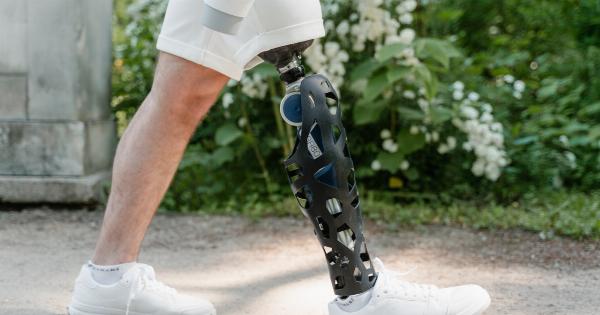Knee osteoarthritis is a common condition that causes pain, stiffness, and decreased mobility in the knee joint. It occurs when the cartilage that cushions the knee joint gradually wears away, leading to bone-on-bone friction and inflammation.
While there is no cure for knee osteoarthritis, certain exercises and activities, such as walking, can help manage the symptoms and improve overall joint health. In this article, we will explore the many benefits of walking for knee osteoarthritis and why it is considered one of the most effective low-impact exercises for individuals with this condition.
1. Low-Impact Exercise
Walking is a low-impact exercise that puts minimal stress on the joints, making it particularly suitable for individuals with knee osteoarthritis.
Unlike high-impact activities like running or jumping, walking helps improve joint function without placing excessive strain on the knees. The controlled and fluid movements involved in walking help lubricate the cartilage and keep the joints mobile, preventing stiffness and reducing pain associated with knee osteoarthritis.
2. Improves Joint Stability
Walking regularly helps improve joint stability, which is important for individuals with knee osteoarthritis. Stronger muscles surrounding the knee joint provide better support and protection to the affected joint.
As you walk, your quadriceps, hamstrings, and calf muscles work together to stabilize the knee joint, reducing the risk of falls and further injury. Improved joint stability also contributes to better balance and overall mobility, enhancing daily activities and quality of life.
3. Weight Management
Maintaining a healthy weight is crucial for individuals with knee osteoarthritis as excess weight puts additional stress on the joints, exacerbating pain and inflammation.
Walking can be an effective tool for weight management as it burns calories, improves metabolism, and promotes fat loss. Regular walking, combined with a balanced diet, can help individuals achieve and maintain a healthy weight, reducing the strain on the knee joints and minimizing the progression of osteoarthritis.
4. Builds Muscle Strength
Walking is often underestimated as a muscle-strengthening exercise. While it is a predominantly aerobic activity, it also engages several muscle groups, especially in the lower body.
Regular walking helps strengthen the muscles around the knees, including the quadriceps, hamstrings, glutes, and calves. Stronger muscles provide better support to the knee joint, reducing joint stress and improving overall joint function.
Increased muscle strength also aids in maintaining mobility and preventing muscle imbalances, common in individuals with knee osteoarthritis.
5. Enhances Flexibility
As knee osteoarthritis progresses, the joint can become stiff and less mobile. Walking, especially when combined with gentle stretching exercises, can improve joint flexibility and range of motion.
Regular walking promotes blood flow to the joint tissues, delivering vital nutrients and oxygen that help maintain the health of the cartilage. Additionally, walking helps lubricate the joints, reducing stiffness and promoting flexibility. Incorporating walking into a daily routine can help maintain natural knee movement and prevent further limitations in mobility.
6. Mood Booster
Exercise, including walking, has been shown to have positive effects on mental well-being. Physical activity stimulates the release of endorphins, known as “feel-good” hormones, which help alleviate pain and improve mood.
Individuals with knee osteoarthritis often experience depression and anxiety due to chronic pain and functional limitations. Engaging in regular walking can reduce stress and improve overall mental health, making it an excellent complementary therapy for managing knee osteoarthritis.
7. Cardiovascular Health
Walking is a gentle cardiovascular exercise that benefits not only your joints but also your heart and overall health. As you walk, your heart rate increases, promoting blood circulation and oxygen delivery throughout the body.
Regular walking strengthens the cardiovascular system, reduces the risk of heart disease, and improves overall cardiovascular health. Maintaining good cardiovascular health is crucial for individuals with knee osteoarthritis as it helps support the joints and enhances their ability to cope with the demands of daily activities.
8. Social Interaction
Walking can be a social activity that promotes interaction with friends, family, or other individuals with similar interests. It provides an opportunity to engage in conversations, share experiences, and enjoy companionship while improving joint health.
Social interaction has a positive impact on mental well-being and can help reduce stress, anxiety, and depression associated with knee osteoarthritis. Joining a walking group, participating in community walks, or simply walking with a friend can make your walking routine more enjoyable and beneficial.
9. Improves Sleep Quality
Individuals with knee osteoarthritis often struggle with sleep disturbances due to pain and discomfort. Regular physical activity, such as walking, has been shown to improve sleep quality and duration.
Engaging in moderate-intensity exercise like walking helps regulate sleep patterns, promotes relaxation, and reduces insomnia associated with knee osteoarthritis. Better sleep quality allows the body to repair and regenerate, enhancing overall well-being and reducing the impact of pain on daily life.
10. Simple and Accessible
One of the greatest advantages of walking is its simplicity and accessibility. Walking requires no special equipment or training and can be easily incorporated into daily routines.
Whether it’s a brisk walk in the park, walking during your lunch break, or using a treadmill at home, there are countless opportunities to include walking in your day. The ability to customize the pace and distance makes walking suitable for individuals with varying levels of knee osteoarthritis severity and fitness levels.
Conclusion
Walking is a beneficial exercise for individuals with knee osteoarthritis, offering a range of physical, mental, and emotional advantages.
The low-impact nature of walking, along with its ability to improve joint stability, assist in weight management, build muscle strength, enhance flexibility, and promote better cardiovascular health, makes it an ideal exercise for those with knee osteoarthritis. Additionally, walking provides opportunities for social interaction, improves sleep quality, and can be easily incorporated into everyday life.
By making walking a regular part of your routine, you can effectively manage the symptoms of knee osteoarthritis and improve your overall quality of life.































